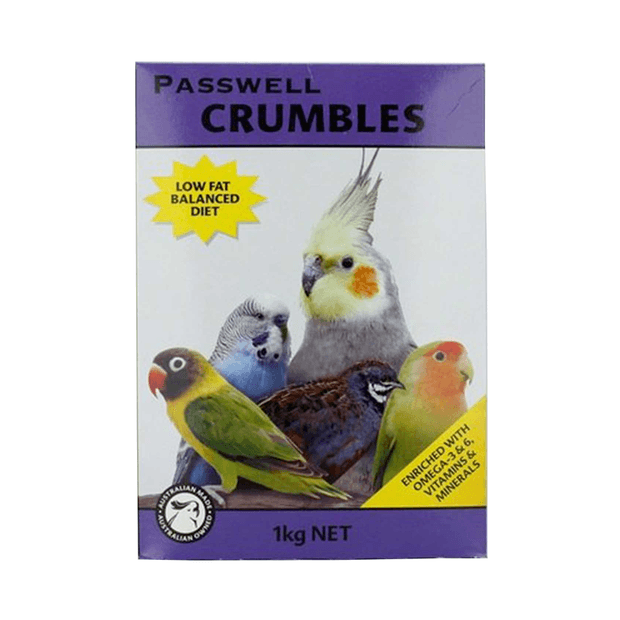Passwell Crumbles 1kg
$12.00
Passwell Crumbles
are a low-fat, balanced diet for small parrots, cockatiels, budgies, lovebirds, canaries, finches, quail and doves. Use crumbles as a nutritional replacement to dry seed in the diet.
- Description
- Additional information
- Ingredients
- Nutritional Analysis
- Feeding Directions
- Feeding Guide
- Reviews (0)
Key Features
- Provides excellent nutrition compared to seed-based diets.
- Improved health through elevated levels of essential amino acids, omega-3 & 6, vitamins and minerals.
- Low fat formula helps with weight control in pet birds.
- Totally edible to reduce waste and mess.
Additional information
| Weight | 1 kg |
|---|
Ingredients
Ingredients
Ground grains including triticale, wheat, barley, maize and oats, whey and soy proteins, meat meal, lysine, methionine, mannan oligosaccharides, β-glucans, vegetable oils, omega-3 and omega-6 fatty acids (including EPA & DHA), carotenoids, vitamins A, B1,B2,B6, B12,C,D3,E,K, nicotinamide, pantothenic acid, biotin, folic acid, choline, inositol, calcium, phosphorus, potassium, sodium, magnesium, zinc, iron, manganese, copper, iodine, selenium.
Nutritional Analysis
Analysis
| Protein (min) | 15% |
| Fat (min) | 5% |
| Carbohydrate (min) | 72% |
| Fibre (max) | 7% |
| Calcium | 0.7% |
| Metabolisable Energy (ME) | 16 MJ/kg |
Feeding Directions
Directions
Feed as a dry crumble, replacing the seed proportion of the bird’s diet:
Birds that are accustomed to eating seed need to modify their feeding technique to eat Crumbles:
- Initially they will disintegrate the food, but they should soon learn to totally consume the Crumbles and even eat any powder produced during feeding.
- Avoid changing the diet on days that are either very hot or very cold, or during times of stress on the bird.
- Observe the birds regularly to ensure they are eating the Crumbles.
- Don’t over-fill the feed bowl, as birds will tend to scatter the Crumbles in search of their normal food
- Have at most two layers of Crumbles in the feed bowl.
Feeding Guide
Feeding Guide
Caged birds tend to over-eat and become obese when offered an unlimited supply of food. It is a healthier, and more economical practice to establish your birds’ daily food requirement and feed that amount.
| Species | Crumbles per bird day (1 teaspoon = 4g approx.) |
|
| grams | teaspoons | |
| Canaries & Finches (10-30g body weight) |
2 – 4 | 1/2 – 1 |
| Budgies, Neophemas & Lovebirds (30-70g body weight) |
4 – 8 | 1-2 |
| Cockatiels & Parrots (80 -120g body weight) |
12 – 16 | 3-4 |
| Small Quail & Doves (25-70g body weight) |
4 – 8 | 1-2 |
| Large Quail & Doves (120 – 150g body weight) |
16 – 20 | 4 – 5 |
Note that these feeding estimates are for non-breeding birds and can vary depending on the size of the bird, nutritional value of other foods eaten, cage size, activity levels and daily temperature.


Reviews
There are no reviews yet.